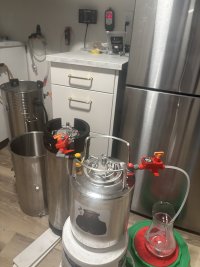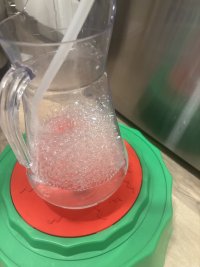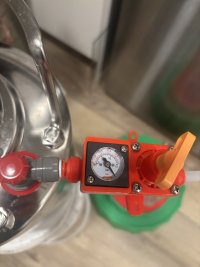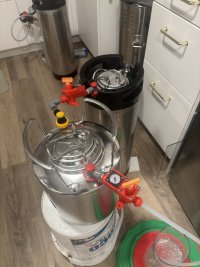- Joined
- May 6, 2025
- Messages
- 299
- Reaction score
- 235
Like many of us I use the fermentation co2 from the fermenting keg to purge the serving keg.
But where to place the spunding valve? Photo below shows how I currently do it. The spunding valve is in the middle, after the fermentation keg and before the serving keg. So the fermenting keg has 12 psi and the serving keg is ambient pressure. The serving keg runs co2 into a jar of sanitizer.
I think there are pros and cons each way.
The pro of my current way is that I have higher volume of gas flowing through the serving keg. The weight of gas produced is the same, but if I put the spunding valve at the end of the chain, then the serving keg would also be 12psi and the gas would be compressed, meaning less volume to flush out oxygen.
But now I am thinking of moving the spunding valve to the end of the chain, to the gas out port on the serving keg. It may make the closed transfer better. Both kegs would have equal pressure. And with lovely pure fermentation gas. I would not have to top up the serving keg with bottle co2.
Looking forward to your thoughts.
But where to place the spunding valve? Photo below shows how I currently do it. The spunding valve is in the middle, after the fermentation keg and before the serving keg. So the fermenting keg has 12 psi and the serving keg is ambient pressure. The serving keg runs co2 into a jar of sanitizer.
I think there are pros and cons each way.
The pro of my current way is that I have higher volume of gas flowing through the serving keg. The weight of gas produced is the same, but if I put the spunding valve at the end of the chain, then the serving keg would also be 12psi and the gas would be compressed, meaning less volume to flush out oxygen.
But now I am thinking of moving the spunding valve to the end of the chain, to the gas out port on the serving keg. It may make the closed transfer better. Both kegs would have equal pressure. And with lovely pure fermentation gas. I would not have to top up the serving keg with bottle co2.
Looking forward to your thoughts.


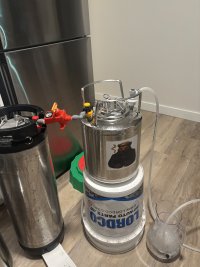









![Craft A Brew - Safale S-04 Dry Yeast - Fermentis - English Ale Dry Yeast - For English and American Ales and Hard Apple Ciders - Ingredients for Home Brewing - Beer Making Supplies - [1 Pack]](https://m.media-amazon.com/images/I/41fVGNh6JfL._SL500_.jpg)













































